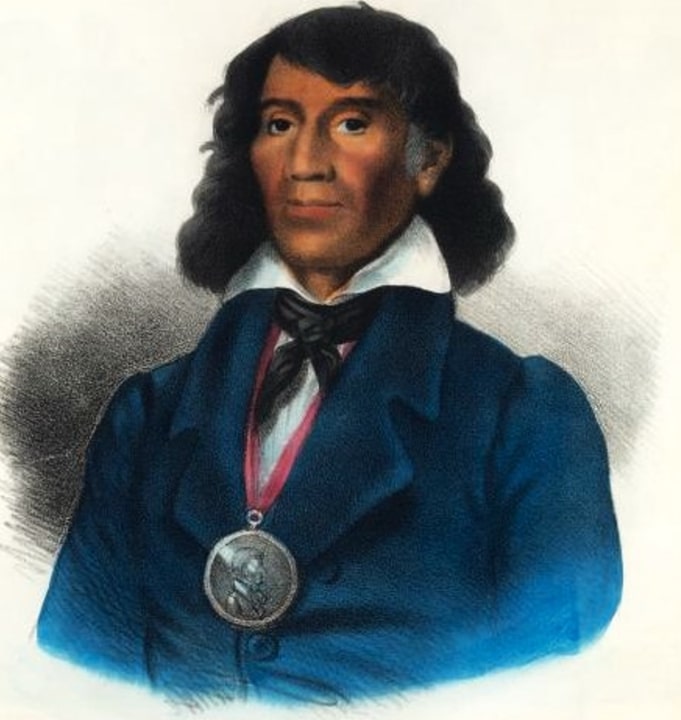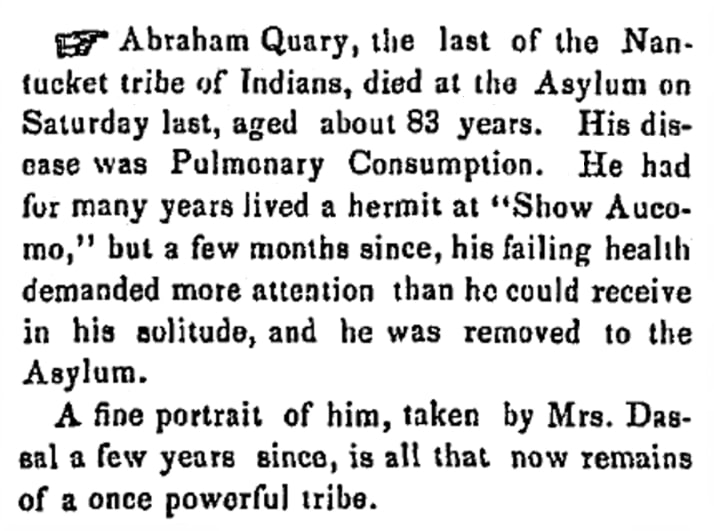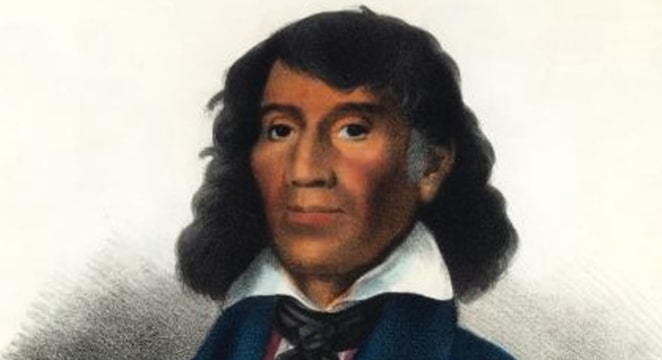Introduction: In this article, Melissa Davenport Berry shows portraits and belongings of Abraham Quary (1768-1854), the last male Wampanoag Indian who lived on the island of Nantucket. Melissa is a genealogist who has a website, americana-archives.com, and a Facebook group, New England Family Genealogy and History.
Of the many precious relics housed at the Nantucket Historical Association (NHA), none has created more intrigue and fascination than ones associated with Abraham “Abram” Quary (1768-1854), the last male Wampanoag Indian who lived on the island of Nantucket.
Jerom Thompson sketched Abraham’s portrait at Nantucket in 1834.

Thompson’s sketch was titled “The Last Indian of the Nantucket Tribe,” and until his death on 25 November 1854, most people believed Abraham was the last of his people. However, it turned out that a female Wampanoag Indian, Dorcas Esop Honorable (c. 1770-1855), who died a few months after Abraham, was truly the last of her tribe on Nantucket.
Mrs. William Russell Sturgis of Mashpee, Massachusetts, recalled visiting Abram at Nantucket with her father Solomon Attaquin (members of the Mashpee Wampanoag Indian Tribe) when she was about 15 years of age. She was 93 when she told the story and said: “Quary was very Indian in appearance, wore long hair, and could speak Indian.” (Indian Notes and Monographs, Vol. 44, p.113)
Nathaniel Philbrick and others have celebrated Abram in their work. He was a man who was respected by all who encountered him. I have compiled many of the publications and historical background on Abram, which can be viewed at Americana-Archives.
I found an obituary for Abram in the Nantucket newspaper archives.

Abram’s obituary refers to “a fine portrait of him, taken by Mrs. Dassal [Dassel] a few years since.” Herminia Borchard Dassel went to Abram’s home and painted several portraits of him in 1851. Some of her work was completed in the studio of George Gardner Fish. Abram died just three years later, in 1854.
One of the relics housed at the Nantucket Historical Association is a blue-painted butter churn used by Abram.
When the Nantucket Historical Association was formed at the home of Mrs. Elizabeth Starbuck in 1854, this churn was among the early objects placed in the collection. It was gifted by NHA founding councilor Mrs. George Gardner Fish, born Judith Jones Derrick to Thomas Derrick and Anna Glazier Chase and the wife of George G. Fish, son of Phineas Fish and Phebe Gardner.
A basket with a pencil notation on the bottom, “Ab. / Quary / 1851 / his / basket,” is also housed at the NHA.
According to Benjamin Franklin Folger, Abram was the son of Sarah Quary, who was the daughter of Joseph Quary, a leader among his people. At an early age Abram was placed in the home of Stephen Chase and became a whaler like many Nantucket natives.
Later Abram sold herbs and berries, but his most noted trade was basket making, a skill he acquired from his mother.
In 2005 artist scrimshander Charles Manghis captured Abram’s image on a whale tooth based on a famous portrait of him.
Another interesting likeness of Abram in the NHA collection is a wooden relief carving. This gem is the work of wood carver Aletha Macy, a direct descendant of Nantucket settler Thomas Macy.
According to an announcement, “Carving of Abram Quary Given Atheneum,” published in the Inquirer and Mirror, Macy’s carving of Abram was done in 1951 and represents more than 700 hours of painstaking work. It was presented to the Nantucket Atheneum Library by Mrs. George Lister Carlisle Jr.
Macy, fascinated by Abram as she brought him to life on the rock maple board, had dug into old island archives for any details on her subject.
To conclude, here is the most famous portrayal of Abram that graced many postcards over the years, a painting of Abram Quary sitting barefoot next to a fireplace and basket of flowers. It is said the home of Abram was on the land once owned by Hezikiah Swain. The original portrait is at the Nantucket Atheneum.
According to sources, when Abram was at home and in the proper mood, he would raise a flag near his dwelling to show that guests were welcome. A visit with this man must have been a true honor.
Explore over 330 years of newspapers and historical records in GenealogyBank. Discover your family story! Start a 7-Day Free Trial
Note on the header image: a close-up of the portrait of Abraham Quary by Jerom Thompson, 1834. Credit: New York Public Library, New York.
